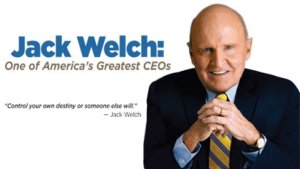 One of the single most competitive advantages for businesses today is their ability to grow, nurture, and develop leadership and management capability faster than the competition. Future business success depends on it.
One of the single most competitive advantages for businesses today is their ability to grow, nurture, and develop leadership and management capability faster than the competition. Future business success depends on it.
That’s a bold statement to make, I know.
But I passionately believe in it, and more importantly, I have seen it have a profound impact in thousands of businesses of all shapes and sizes. If you want to accelerate and fast track the success of your business, and build sustained high performance, developing your leadership culture is among your biggest priorities.
Where are you on your journey in building leadership and management capability and developing a Leader-Leader culture in your business?

If you’re a sole trader, leadership and management responsibility probably sits with you. If you’ve got a small team, it is more important than ever as you need every single one of your people aligned and performing at their peak. If you run a much bigger organisation, creating consistency and building strength at every level is critical to succession planning, creating the stretch, and the capacity to grow your business.
Leadership is the enabler to turn your vision and goals into reality!
If you have ambitions to grow your business, then it cannot be all about you.
Jack Welch really understood this principle when he said: ‘Before you are a leader, success is all about growing yourself. When you become a leader, success is all about growing others.’

He was chairman and CEO of General Electric between 1981 and 2001, the youngest CEO in the company’s history. During his tenure, GE’s value rose 4,000% and when he retired, he received a severance payment of $417 million, the largest such payment in history.
Now what was impressive about this?
Was it that he ran a global business for 20 years (an impressive feat in itself when you think about turnover of CEOs today)? Was it the 4,000% increase in the share price over that period? Was it the huge pay-out on retirement?
Actually, what was really impressive was what he did in his first 90 days in office – he set up a Leadership Academy. Welch had a core philosophy: for the business to be successful it needed the best leadership capability, and he was prepared to attach part of his legacy to this philosophy. Welch became known for growing and teaching leaders.
The success of the organization, particularly the 4,000% increase in the share price, was the by-product of a relentless and unwavering focus on developing people and leaders. At the last count more than 35 CEOs in today’s top companies trained and served under Jack Welch.
And if ever you needed further reinforcement of the importance of leadership capability today, leadership strength is one of the top 10 ‘value enhancing differentiators’ that accountants, private equity, and venture capital specialists utilize in valuing businesses.
If you have an aspiration to float or sell your business, your leadership capability will directly affect your multiplier and business valuation.
The starting point… develop a leadership culture in your business
Firstly, developing a leadership culture expands the essence of your organisational culture by adopting an entirely new take on leadership.
A leadership culture operates from a solid core of personal ownership, each individual taking responsibility and accountability for their actions and results; where everyone thinks, feels, and acts like it’s their business, regardless of their job title, office, or place on the hierarchy.

It’s where individuals:
- Are enterprising, entrepreneurial, and proactive
- Are focused on getting to the solution rather than concentrating on the problem (the glass is definitely half full, not half empty!)
- Do whatever it takes to build a legacy world-class business that is revered by the competition, sets the benchmark for industry standards, and is known as a great place to work
- Are concerned about results and outcomes, and do their part to reduce costs
- Take personal ownership for achieving results that move the business forward (whether they work in the post room or sit in the boardroom)
- Shape the culture, stay positive, and lead by example.
Two distinct groups of people: leaders and followers.
A book I highly recommend for its many great lessons is Turn the Ship Around! by L. David Marquet, a retired US Navy captain.

Within its pages, Marquet offers a really interesting definition of leadership straight from the US Navy handbook, which says: ‘Leadership is the art, science, or gift by which a person is enabled and privileged to direct the thoughts, plans, and actions of others in such a manner as to obtain and command their obedience, their confidence, their respect, and their loyal cooperation.’
It’s especially interesting when you dissect and interpret it, because what it is in effect saying is that leadership in the US Navy (and in fact in many organizations) is about controlling people. It divides the world into two distinct groups of people: leaders and followers.
The leader-follower structure has been with us for generations and is perpetuated through organizations to this very day. A hierarchical, command and control structure with decision-making from the top is what we know, and for good reason.
Throughout history, a number of great achievements have been accomplished through the leader-follower model, and it has enabled many people to achieve success in their chosen field.
It is exactly because the leader-follower way of doing business has been so successful that it is so hard to give up.

But the Leader-Follower structure is at odds with developing a leadership culture
People who are treated like followers have the expectations of followers and act like followers. That means they have limited decision-making authority and little incentive to give the utmost of their intellect, energy, and passion. Those who take orders usually run at half speed, under-utilizing their imagination and initiative.
In a leader-follower model, all decision-making defaults to the leader and therefore the organization gets squashed, constrained, and contracted, reducing the headspace to grow the organization.
It can be particularly challenging when the leader is exceptionally charismatic, or worse, when they’re an out-and-out autocrat, because the ability of people to shine is increasingly limited over time.
In a leader-follower structure, the performance of the organisation is closely linked to the ability of the key leader at the top, so inevitably there is a natural tendency to develop personality-driven leadership; an approach that might deliver short-term results, but will never allow you to build a high performing, sustainable, legacy organisation.
Sign up for my LIVE WEBINAR ‘How to build a self-sustaining leader-leader culture where people are performance led, not performance managed’ and I’ll show you how to overcome these challenges.
The Solution: Leader-Leader Structure
A leader-leader structure is fundamentally different from the leader-follower model.
At its core is the belief that we can all be leaders, and in fact, it’s best when we all are.
Leadership is not some mystical quality that some possess and others do not. As humans, we all have what it takes, to take the lead under specific circumstances.
The leader-leader model not only achieves great improvements in effectiveness and morale but also makes the organisation stronger. Critically, these improvements are enduring, decoupled from the leader’s personality and presence.
Leader-leader structures are significantly more resilient, and they do not act as if the designated leader is always right. Further, leader-leader structures naturally spawn additional leaders throughout the organization.
It’s a force that can’t be stopped.

The faster you can get every single person in your business to embrace and demonstrate leadership behaviours, regardless of their position, the quicker you’ll secure your position as a world-class organisation.
The race is on to grow leaders, team members, and colleagues fast.
You must develop a leader-leader structure and a leadership culture before your competitors do!
Sign up for my LIVE WEBINAR ‘How to build a self-sustaining leader-leader culture where people are performance led, not performance managed’
You’ll discover the 7 guiding principles to building a self-sustaining leadership culture which will become an integral part of your critical thinking, filter and blueprint for any leadership development moving forward.

